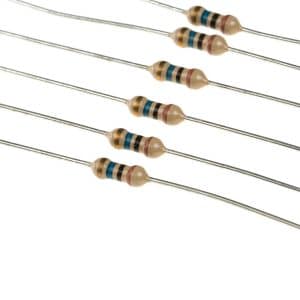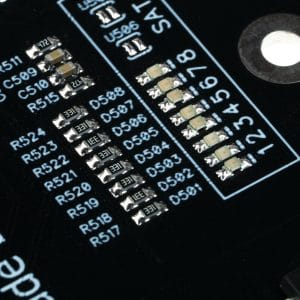What are Resistors, and How Do I Use Them?
A resistor is an electrical component with a controlled resistance. Resistance is the electrical property that resists the flow of electricity and is measured in the unit “Ohms”, which is denoted by the capital Greek letter Omega (Ω). The higher the resistance, the less current flows through the resistor with the same voltage. This property can be used for many applications, including reducing the voltage of a signal or limiting the current running through an LED.
How do I use resistors?
Calculate Voltage and Current using Ohm’s Law
Resistors are related to the electrical properties of Voltage and Current using the equation known as Ohm’s Law, named after the German physicist Georg Ohm. Ohm’s law states that voltage across a resistor is directly proportional to the product of its resistance and the current passing through it.
\(\large V=I \times R, \quad I=\frac{V}{R}, \quad R=\frac{V}{I}\)
Limiting Current with a Resistor
Suppose you have 5V and you want to connect a resistor to the source and have 10mA flow through the circuit. We can calculate the resistance required using Ohm’s law.
\(\large R=\frac{V}{I}=\frac{5V}{0.010A}=500\Omega\)
Calculate Power using Joule’s Law
As a resistor restricts the current flow in a circuit it also consumes part of the power flowing through it. This consumed power is released as heat. In order to properly size a resistor for its application, the resistor’s power rating (1/4W for typical through-hole resistors) must exceed the power it dissipates in the circuit.
The power a resistor dissipates is calculated using an equation known as Joule’s Law, which states that the heat generated by an electrical conductor is proportional to the product of its resistance and the square of the current. Combining this fact with Ohm’s Law yields the following equation.
\(\large P=I^2 \times R = I \times V = \frac{V^2}{R}\)
Power Comsumed in a Resistor
Using the equation above, we can continue the above example and calculate the power dissipated by the 500 Ohm resistor with 0.010A flowing through it.
\(\large P=I^2 \times R = 0.010A^2 \times 500\Omega = 0.05W = 50mW \)
The power dissipated by a 500 Ohm resistor with 0.010A traveling through it is 0.1mW, which is far below the 1/4W rating of most through-hole resistors, and therefore would be perfectly acceptable in a circuit.
How to Read Resistor Values
Through-Hole Resistors
The resistivity of a through-hole resistor is generally denoted by bands of color around the resistive element of the resistor. The color and placement of each of these bands correlate to the resistors value and tolerance. These markings can be decoded using our Resistor Color Codes chart.
Surface Mount (SMT) Resistors
The resistivity of SMT resistors is usually marked on the top of the package in the form “4R7” or “101”. The “R” in “4R7” acts as a decimal, meaning the resistance is 4.7 Ohms. The marking “101”, or three numbers, uses the first two digits as the value and the final digit as a power of ten multiplier. Thus “101” means $latex R = 10 \times 10^1 = 100 \Omega$, or “203” would be \(\large R = 20 \times 10^3 = 20,000 \Omega = 20 k\Omega\).
Try It Yourself!
The simulator shows a visual representation of Ohm’s Law. On the left is a 5V source that is driving current through the four resistors on the right. Notice how the current moves more quickly through the resistors with less resistance, and more slowly through the resistors with higher resistance.



